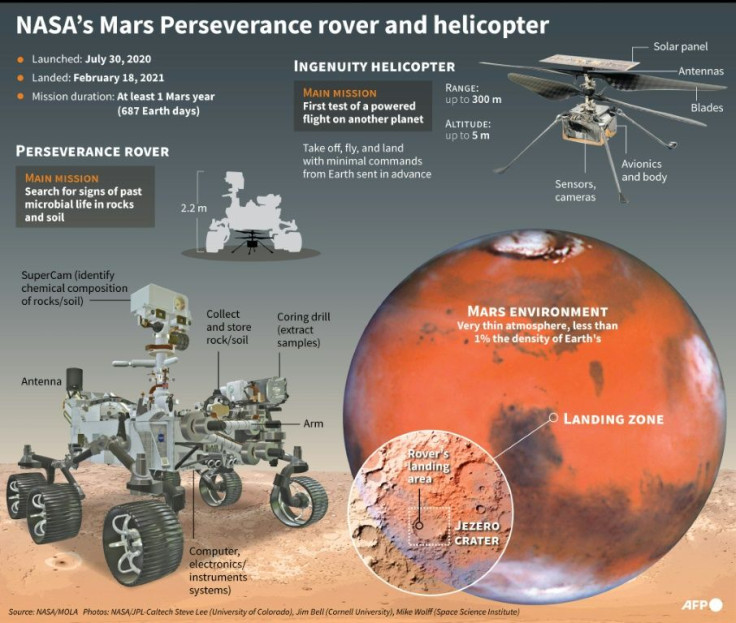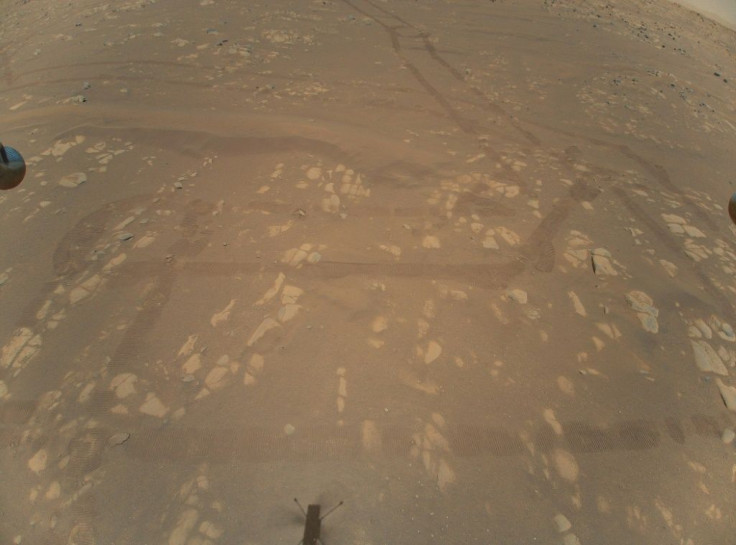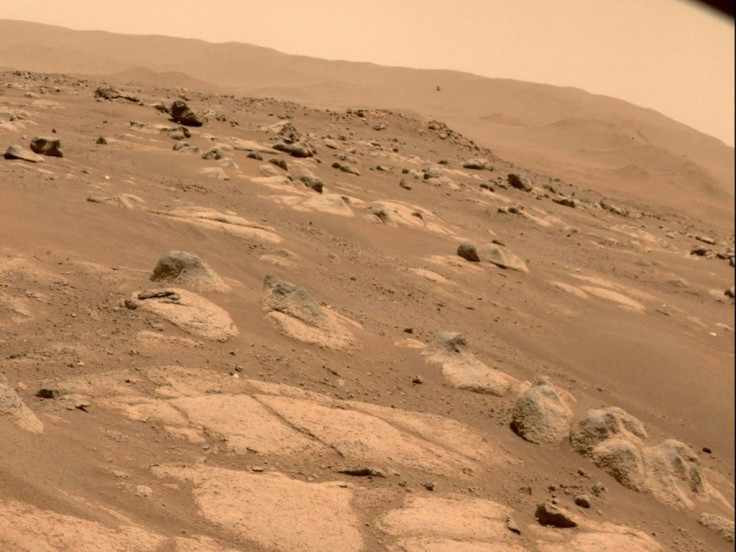Perseverance Rover Captures Sound Of Ingenuity Flying On Mars
NASA's Perseverance rover has for the first time captured the low-pitched whirring of the Ingenuity helicopter's blades as it flies through the rarefied Martian atmosphere.
The space agency on Friday released new footage shot by the six-wheeled robot of its rotorcraft companion making its fourth flight on April 30 -- this time accompanied by an audio track.
The nearly three-minute-long video begins with the low rumble of wind blowing across the Jezero Crater, where Perseverance landed in February on a mission to search for signs of ancient microbes.

Ingenuity takes off, and its blades can be heard humming softly as they spin at nearly 2,400 rpm on the 872-foot (262-meter) roundtrip.
The mission's engineers weren't sure they would pick up the flight sound at all, given that Perseverance was parked 262 feet (80 meters) away from the takeoff and landing spot.
The Martian atmosphere is about one percent the density of our planet's, making everything much quieter than on Earth.

"This is a very good surprise," said David Mimoun, a professor of planetary science at Institut Superieur de l'Aeronautique et de l'Espace (ISAE-SUPAERO) in Toulouse, France, and science lead for the SuperCam Mars microphone.
"We had carried out tests and simulations that told us the microphone would barely pick up the sounds of the helicopter, as the Mars atmosphere damps the sound propagation strongly," he added.
The SuperCam is an instrument on board Perseverance that laser-zaps rocks from a distance, in order to study their vapor with a device called a spectrometer that reveals their chemical composition.
It also comes with a microphone to record the sounds, which yields additional insights into the physical properties of the targets, like how hard they are.

Similarly, explained Mimoun, the new recording of Ingenuity's flight "will be a gold mine for our understanding of the Martian atmosphere."
Apart from having a lower volume, sounds emitted on Mars travel slower than they do on Earth, because of cold temperatures, which average -81 degrees Fahrenheit (-63 degrees Celsius) on the surface.
The speed of sound on the planet is therefore around 540 mph (roughly 240 meters per second), compared to about 760 mph (roughly 340 meters per second) here.

The atmosphere of Mars, made up of 96 percent carbon dioxide, tends to absorb higher-pitched sounds, so only lower-pitched sounds can travel long distances.
NASA enhanced the audio, which was recorded in mono, by isolating the pitch of the helicopter blades at 84 hertz, and reducing audio at frequencies below 80 and above 90 hertz. They then increased the volume of the remaining signal.
Soren Madsen, Perseverance payload development manager at NASA's Jet Propulsion Laboratory, said the recording was an example of how the mission's instruments are able to work in tandem to enhance our understanding of the Red Planet.
As Ingenuity moves away from Perseverance and out of shot, the pitch decreases and as it returns the pitch increases.
This is known as the Doppler effect, and it provides an additional layer of confirmation of the helicopter's flight path when it is out of visual range.
Ingenuity made the first powered, controlled flight on another planet on April 19, and flew a fifth time on Friday at 3:26 pm Eastern Time (1926 GMT).
After receiving telemetry data several hours later, NASA confirmed the flight's success on Twitter, posting a new picture of the chopper taken from Perseverance.
Friday's sortie was Ingenuity's first one-way trip, setting the stage for it to begin a new job as Perseverance's scout.
The next phase extends the rotocraft's mission beyond the original month-long technology demonstration. Now, the goal is to assess how well flyers can help future exploration of Mars and other worlds.
The four pound (1.8 kilogram) mini-chopper was given this assignment after proving itself more robust than its engineers had anticipated.
Perseverance's science team also decided they wanted to stay in the immediate surroundings longer than they first thought, making it possible for the two robots to work together.
The type of reconnaissance Ingenuity performs could one day also prove useful to human missions, by scoping out the best paths for explorers to traverse, and reaching locations that aren't otherwise possible.
© Copyright AFP 2024. All rights reserved.





















